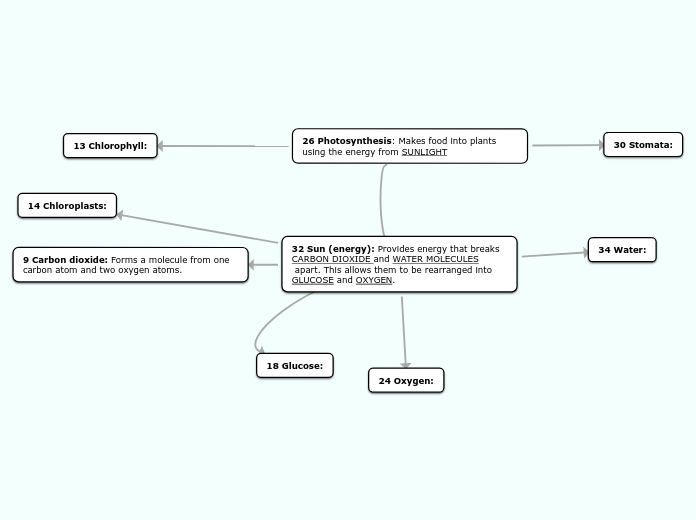26 Photosynthesis: Makes food into plants using the energy from SUNLIGHT
32 Sun (energy): Provides energy that breaks CARBON DIOXIDE and WATER MOLECULES apart. This allows them to be rearranged into GLUCOSE and OXYGEN.
9 Carbon dioxide: Forms a molecule from one carbon atom and two oxygen atoms.
28 Reduction: To make sugars, elections and H+ ions are transferred to carbon dioxide.
6 Calvin Cycle reactions: Assembles sugar molecules from carbon dioxide
34 Water: Used as a raw material for photosynthesis. Energy breaks the H2O bonds.
22 Light reactions: Provides energy for the photosynthesis reaction.
2 ATP synthase: Light reactions produce ATP which then enters the CALVIN CYCLE.
^
23 Oxidation: Water gets oxidized because hydrogen is removed.
18 Glucose: The energy from the sun is use to form glucose. Glucose helps plants grow.
14 Chloroplasts: Food producers of the cells.
7 Eukaryote (s): Photosynthesis occurs in a chloroplast which arise in eukaryotes.
30 Stomata: Exchanges oxygen and CO2.
13 Chlorophyll: Reflects green inside the chloroplasts of the cells.
24 Oxygen: Oxygen is a product of photosynthesis.
3 Autotroph: Uses photosynthesis to transform what plants use as food.
8 Carbohydrates: Photosynthesis uses carbohydrates to combine with other sugars to form a plants structure.
20 Heterotroph: Depends on photosynthesis as a source of oxygen.
31 Stroma: Chemical changes that occur in photosynthesis are completed in the stroma.
25 Photorespiration: Photosynthesis produces plant metabolism within photorespiration.
4 C3 plants: Photorespiration occurs in C3 plants.
5 C4 plants: Prevent photorespiration.
